Physical Address
304 North Cardinal St.
Dorchester Center, MA 02124
Reactive and neoplastic lesions of the ear are infrequent but may pose diagnostic difficulties for the pathologist. The inner ear is composed of a specific form of inert bone, a virtually nonmitotic sensory area, and nerves. Its tumors are mainly those of Schwann cell lineage, the only relatively labile cells in that region. The middle ear is lined by a simple flat epithelium, but its ability to respond briskly to inflammation by the production of glands (mucosal metaplasia) explains why the adenoma is the most common of middle ear neoplasms. The external ear is a specialized appendage of the skin and its neoplasms largely reflect the range seen in other cutaneous areas.
First branchial cleft anomalies encompass a spectrum of benign, congenital lesions occurring in the parotid gland, posterior submandibular space, or preauricular region, presenting as a fistula, sinus, or cyst, due to the incomplete fusion of the first and second branchial arches, with persistence of the ventral component of the first branchial cleft. The first branchial cleft gives rise to the external auditory canal (EAC); the first branchial arch gives rise to the mandible, muscles of mastication, auditory ossicles (incus body and malleus head), and cranial nerve (CN) 5; and the first branchial pouch gives rise to the eustachian tube (ET), middle ear cavity, and mastoid air cells. Defects of the first branchial cleft are uncommon, representing less than 10% of all branchial cleft anomalies. These lesions may persist as a blind pouch, a fistula, or a sinus ( Fig. 30.1 ). About two-thirds of these remnants present as fistulas and sinuses rather than cysts. Classification of these embryologic anomalies was first introduced in a classic work by Work and Proctor. In this classification scheme, lesions are divided into Work Type I (ectodermal) and Type II (ectodermal and mesodermal). Work Type II are more common than Type I and although most lesions are discovered in early childhood (<10 years), Work Type I anomalies are usually seen in adults. Females are affected more often than males (2 : 1). Most lesions present as preauricular and immediately postauricular painless, soft, compressible masses frequently involving the parotid gland. In particular, they are not associated with pretragal cysts, pits, or sinuses. There may be a draining sinus tract onto the periauricular skin (especially Work Type II). Rarely there will be an unexplained otorrhea or purulent drainage from the ear canal or a recurrent parotid gland abscess. Isolated cases show syndrome association (Melnick-Fraser syndrome). The lesion may wax and wane, especially with upper respiratory tract infections. If lesions are managed by incision and drainage alone, they are likely to recur. Thus, surgery is the treatment of choice. Preoperative contrast-enhanced computed tomography or magnetic resonance will define the specific type of lesion and its anatomic extent (EAC, mandible, facial nerve, or parotid gland involvement). Complete surgical excision includes the whole fistula, which may terminate in the EAC at the bony-cartilaginous junction.
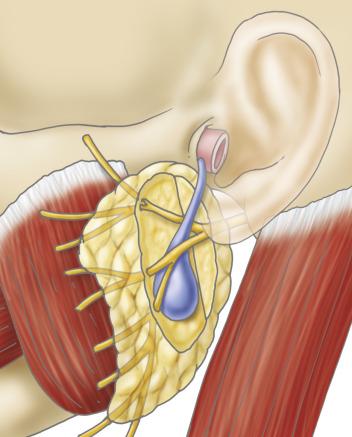
Macroscopically there will be a discrete cyst, sinus, or fistula, or a combination of these structures. The fluid content is cloudy to purulent, viscid, and often contains necrotic debris. Cartilage may be seen ( Fig. 30.2 ). A sinus tract, if noted, should be probed. Microscopically there is a cyst, sinus ( Fig. 30.3 ; see also Fig. 30.2 ), or fistula lined by stratified squamous or ciliated respiratory epithelium. Isolated lymphoid aggregates may be present in the cyst wall. Work Type I lesions are of ectodermal origin only and show a unilocular cyst lined by stratified squamous epithelium or ciliated respiratory epithelium (see Fig. 30.3 ); they tend to be preauricular and parallel to the EAC, with or without a sinus tract. Work Type II lesions show a similar epithelial lining (ectoderm) plus cutaneous adnexal structures and/or cartilage (mesoderm; see Fig. 30.2 ). In many cases, serial or deeper sections may be required to identify the cartilage or adnexal tissue. Type II lesions tend to be posterior and inferior to the angle of the mandible, with a sinus tract to the bone/cartilage junction of the EAC. When infected, the epithelium becomes largely denuded and replaced by heavily inflamed granulation tissue.
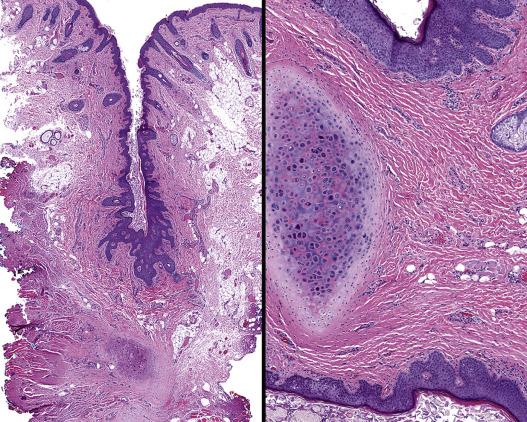
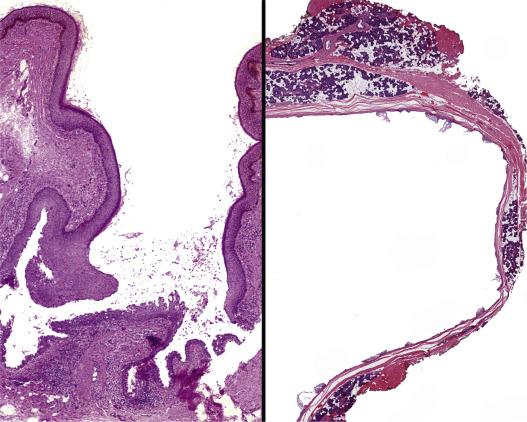
In general, fine-needle aspiration is recommended in the evaluation of all neck cysts. Moreover, if there is a residual cyst after antibiotic therapy, an aspiration should be performed. The smears will be cellular, comprised of anucleate squamous and mature squamous epithelium in a background of amorphous debris and macrophages, although an inflammatory infiltrate is not usually seen. Respiratory type epithelium is occasionally seen.
The histologic differential diagnosis is usually limited, and frequent considerations include an epidermal inclusion cyst, benign lymphoepithelial cyst, folliculitis, and metastatic cystic squamous cell carcinoma. An epidermal inclusion cyst is histologically identical, thus requiring clinical information about a sinus/fistula or the presence of mesodermal components (adnexal structures and/or cartilage) to make the distinction. A benign lymphoepithelial cyst shows intimate blending of epithelium with lymphoid tissue and is often within or adjacent to the parotid gland. Folliculitis tends to be more superficial, centered around the hair shaft or follicle (root) and lacks a sinus/fistula. The age at presentation will usually help exclude a metastatic cystic squamous cell carcinoma, which involves a lymph node, and shows a thick fibrous capsule and ribbonlike distribution of atypical immature epithelium.
This benign glandular neoplasm of ceruminous glands (modified apocrine sweat glands) arises solely from the external auditory canal. By definition, this tumor type cannot involve the auricular cartilages, ear lobe, or other such external ear apparatus and is not synonymous with cylindroma. Ceruminous adenoma accounts for less than 1% of all external ear tumors, usually affecting middle-aged patients (mean age 55 years) without sex predilection. Patients usually present with a mass of the posterior wall of the outer one-third to one-half of the external auditory canal. There may be associated pain, hearing loss (sensorineural and conductive), tinnitus, or even paralysis of the nerves. Complete excision is curative; incomplete excision is associated with risk of recurrence.
Most tumors are small (mean 1.2 cm), in keeping with the anatomic confines of the region. Grossly polypoid, these masses are usually fragmented during removal. The tumors are separated histologically into three types: ceruminous adenoma, ceruminous pleomorphic adenoma, and ceruminous syringocystadenoma papilliferum. Regardless of the type, these tumors tend to be well circumscribed but unencapsulated. The surface epithelium may be involved but is not the site of origin ( Fig. 30.4 ). There is frequently a background of dense, sclerotic fibrosis simulating invasion ( Fig. 30.5 ). The tumors are moderately cellular, arranged in a mixture of glandular and cystic patterns each comprised of a dual cell population.
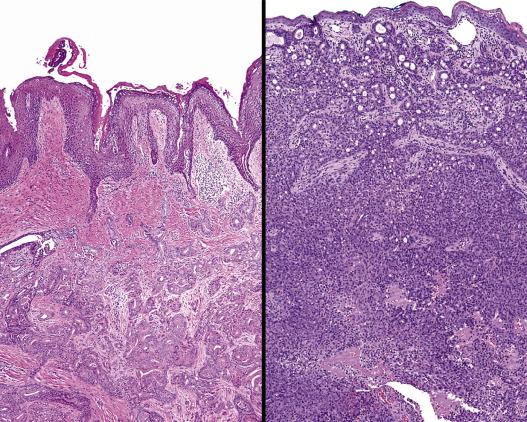
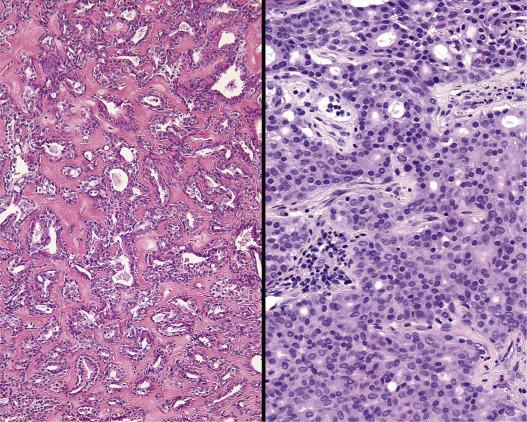
The inner luminal secretory cells have apocrine decapitation secretions or blebs and abundant granular, eosinophilic cytoplasm. Specifically there are yellow-brown, ceroid, lipofuscin-like (cerumen) pigment granules within the cytoplasm of these luminal cells ( Fig. 30.6 ). These cells are surrounded by basal, myoepithelial cells lined up along the basement membrane ( Fig. 30.7 ). There is usually very limited pleomorphism and a lack of necrosis. Mitoses are inconspicuous.
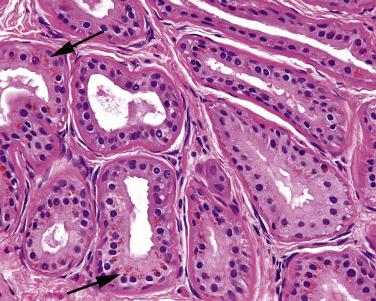
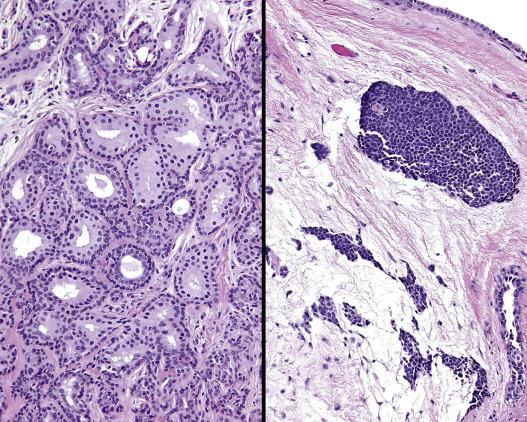
A ceruminous pleomorphic adenoma is identical to a salivary gland pleomorphic adenoma, thus showing chondromyxoid matrix material juxtaposed to and blended with epithelium, with the added feature of ceruminous differentiation among the epithelial cells (see Fig. 30.7 ). It is important to separate a primary external auditory canal tumor from a parotid salivary gland tumor with local extension into the ear. The ceruminous papillary cystadenoma papilliferum has papillary projections lined by cuboidal to columnar cells, a dense plasmacytic infiltrate, and cells with ceruminous differentiation. Although skin-based primaries develop, these tend not to involve the external auditory canal.
Immunohistochemistry is not necessary for the diagnosis, but stains can be used to highlight the biphasic nature of the tumor cells. The luminal cells are positive for CK7, EMA, and pankeratin; the latter two also being positive in the basal cells. Additionally, the basal cells stain with CK5/6, p63, and S-100 protein. CD117 is preferentially expressed in the luminal cells but can be seen in both cell types ( Fig. 30.8 ). There is no reaction with chromogranin, synaptophysin, CD56, or CK20.
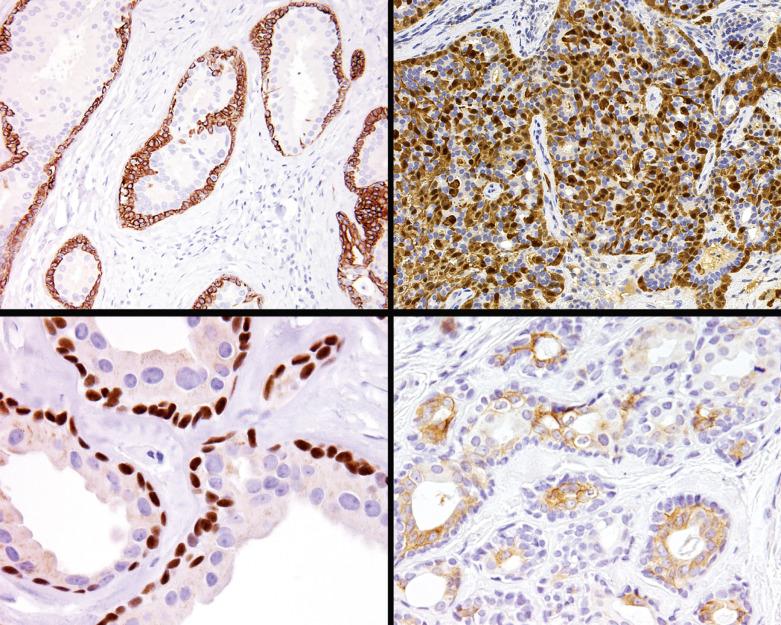
This tumor type is unique to the external auditory canal. With the exception of ceruminous adenocarcinoma, other neoplasms are uncommonly identified in this location. Ceruminous adenocarcinoma has an infiltrative and destructive growth pattern with pronounced cellular pleomorphism and prominent nucleoli. Mitoses and necrosis can be seen. Ceroid pigmentation is absent. Ceruminous adenocarcinoma is also divided into types but it is the not otherwise specified (NOS) type rather than the adenoid cystic type that would give the most difficulty in the differential diagnosis. A middle ear adenoma may expand from the middle ear into the medial aspect of the external auditory canal. This tumor also has a biphasic appearance but the cells are plasmacytoid to cuboidal, have salt-and-pepper nuclear chromatin distribution, lack decapitation secretions, and have no ceroid granules in the cytoplasm. Furthermore they are positive for chromogranin, synaptophysin, CD56, and other peptides. A paraganglioma shows a classic Zellballen (nested) architecture composed of monomorphic cells with basophilic, slightly granular cytoplasm. Isolated or scattered nuclei may show significant pleomorphism. The paraganglia cells are immunoreactive with chromogranin, synaptophysin, and/or CD56, consistent with their neuroendocrine origin, while the sustentacular (supporting) cells stain with S-100 protein. An endolymphatic sac tumor develops within the endolymphatic sac of the temporal bone but may expand into the external auditory canal. The tumor cells are arranged in a papillary architecture with cystic spaces, lined by low cuboidal cells with pale to clear cytoplasm.
Ceruminous adenocarcinoma is a malignant neoplasm derived from ceruminous glands of the EAC. The anatomic site is critical in evaluating this rare neoplasm; specifically it must involve the outer one-third to one-half of the EAC. Patients are usually middle aged (mean 49 years), with a slight female predominance (1.5 : 1). Patients present with pain most commonly, followed by hearing loss, tinnitus, drainage, discharge, bleeding, or a slow-growing mass. A wide, radical (complete) resection is required especially for the adenoid cystic carcinoma type. Radiation is only used for palliation, and usually for cases of ceruminous adenocarcinoma, NOS and mucoepidermoid carcinoma. Recurrences are common, especially if the margins are positive. The overall prognosis is about 50% at 5 years.
Tumors are frequently removed piecemeal, but in situ are generally polypoid, involving the posterior canal. Surface ulceration is common. Overall the tumors are small (mean 1.4 cm) but this may be a result of patients seeking clinical attention early in the disease development. Histologically tumors are separated into three main subtypes: ceruminous adenocarcinoma, NOS; ceruminous adenoid cystic carcinoma; and ceruminous mucoepidermoid carcinoma. Regardless of subtype, these tumors infiltrate into the surrounding soft tissue, benign ceruminous glands, and even cartilage or bone ( Fig. 30.9 ). Perineural invasion and central comedonecrosis ( Fig. 30.10 ), features only identified in carcinoma, may be seen. Although not arising from the surface epithelium, there is frequent surface epithelial involvement. The tumors are cellular and may be arranged in a variety of different patterns: solid, cystic, cribriform, glandular, and even single cell. There is usually cellular pleomorphism, with nuclear variability and prominent nucleoli ( Fig. 30.11 ). Mitoses, including atypical forms, can be found usually in the range of one to four per 2 mm 2 . The stroma between the neoplastic islands is usually desmoplastic. Conspicuous by its absence in these tumor cells are the ceroid (cerumen, wax) pigment granules normally found in the cytoplasm of benign ceruminous glands ( Fig. 30.12 ). Ceruminous adenoid cystic carcinoma shows a cribriform architecture, glycosaminoglycan material in the ovoid spaces, replicated basement membrane, roughly peg-shaped or carrot-shaped nuclei, and usually inconspicuous nucleoli (see Figs. 30.9 and 30.12 ). Perineural invasion is common. Ceruminous mucoepidermoid carcinoma shows cysts and epidermoid or transitional epithelium with mucocytes (true goblet cells; see Fig. 30.11 ). Both variants are characterized by the presence of ceruminous glands intermixed with the neoplastic proliferation. Consequently, in these subtypes it is especially important to exclude direct extension from a parotid salivary gland primary.

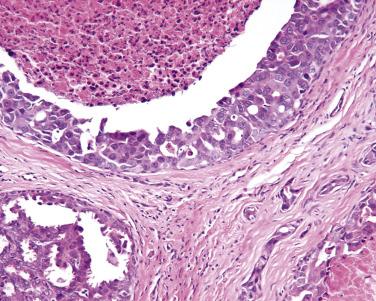
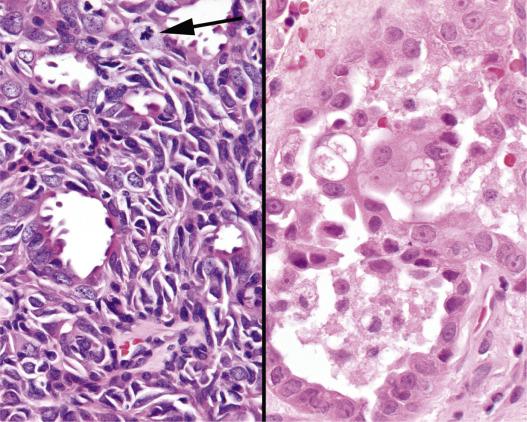
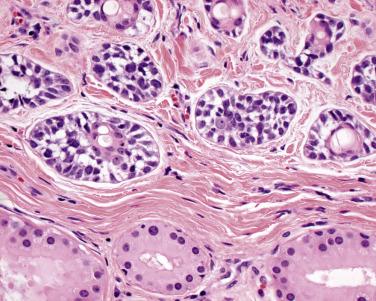
Immunohistochemistry can be used to highlight the biphasic nature of the tumor. The luminal cells are positive with CK7 and CD117, while the basal cells are positive with p63 (nuclear), S-100 protein (cytoplasmic and nuclear), and CK5/6.
The most common differential diagnostic consideration is ceruminous adenoma. (The adenoid cystic and mucoepidermoid patterns are not seen in a benign tumor, of course.) In general, ceruminous adenoma is circumscribed and noninfiltrative, showing a dual cell population that lacks atypia and is characterized by apical snouts and cerumen granules in the luminal cells. Middle ear adenoma affects a different anatomic site, is infiltrative, and demonstrates multiple different patterns. There is a glandular architecture with a dual cell population, and the nuclei show a delicate, salt-and-pepper chromatin distribution. The neoplastic cells will react positively with neuroendocrine markers, including chromogranin, synaptophysin, and CD56. Finally, the distinction between a primary tumor versus direct extension from a parotid salivary gland tumor is important. This separation is critical for adenoid cystic carcinoma extending from the parotid gland, as management would be different. From a histologic perspective, ceruminous differentiation may help to make the distinction but this is usually more easily achieved with imaging and clinical correlation.
Basal cell carcinoma (BCC) is a low-grade malignancy of basal keratinocytes. The etiology is multifactorial, related to sun exposure, radiation, and immunosuppression. The tumor is common, typically seen in older adults, with males affected more often than females. Caucasian, light-skinned individuals have a higher frequency of tumors. There is typically a pearly, waxlike papule, plaque, or nodular lesion, often ulcerated with scale crust. The tumors are slow growing. Complete excision or electrodessication and curettage yields an excellent prognosis. More aggressive subtypes, including micronodular, infiltrative, desmoplastic, and basosquamous, have higher rates of recurrence and a low risk of metastasis.
Tumors are quite variable in size, ranging from a few millimeters to several centimeters. Histologically the tumor is arranged in a nodular, nested, or trabecular (infiltrative cords) architecture and comprised of small basaloid cells with peripheral palisading ( Fig. 30.13 ). The cells have a high nuclear-to-cytoplasmic ratio with enlarged, hyperchromatic nuclei with inconspicuous nucleoli. Numerous mitoses and apoptotic figures are usually present. Mucinous material may be seen within the tumor. Intratumoral or peritumoral calcifications (psammoma body–like) are also frequently present. There is a characteristic retraction artifact between the tumor cells and their stroma (stromal retraction) ( Fig. 30.14 ). The identification of this artifact is helpful in separating this tumor from others in the differential diagnosis. Not infrequently there is excoriation and/or surface ulceration with overlying serous crust. This ulceration often induces squamous proliferation, which may partially obscure the basaloid appearance of the tumor.
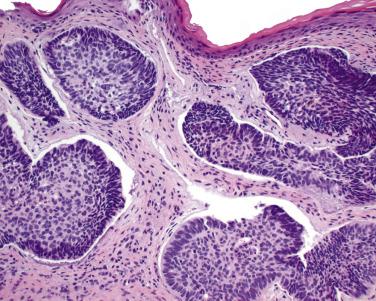
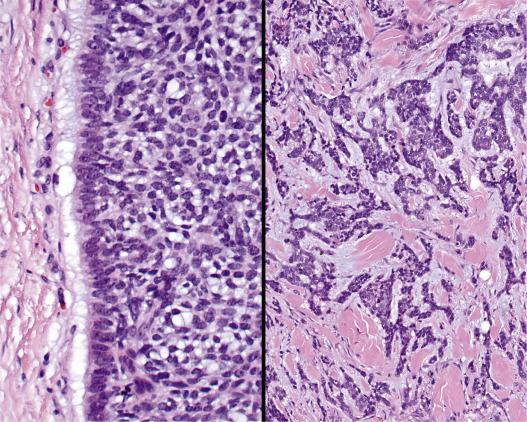
Several dozen variants are reported but only a select few are clinically significant or occur with any frequency on the skin of the ear:
Superficial multifocal (multicentric): Superficial nests attached to the lower border of the epidermis and separated horizontally by areas of uninvolved epidermis
Nodular : Large, rounded, predominantly dermal-based nests with prominent peripheral palisading
Micronodular : Predominantly a dermal-based infiltrative proliferation of small nests, possibly showing epidermal attachment
Infiltrative : Small cords and nests, often deeply invasive
Desmoplastic/morpheaform : Infiltrative strands and nests associated with dense, heavily sclerotic stroma (accounting for about 25% of ear lesions ; see Fig. 30.14 )
Infundibulocystic : Mature folliculocystic spaces containing keratinous material associated with the basaloid proliferation
Basosquamous/metatypical : Prominent squamous differentiation, with less peripheral palisading
The clinical significance of most of these variants is the increased risk of recurrence and/or greater difficulty in achieving complete eradication after standard treatment.
There is usually little reason to perform immunohistochemical stains for basal cell carcinoma. However, they may be useful when trying to separate basal cell carcinoma from trichoepithelioma and trichoblastoma (BCC shows greater staining for bcl-2, p53, and Ki-67) or from squamous cell carcinoma (SCC) (BCC is positive for Ber-Ep4). In the latter case, cytokeratins and p63 are not particularly helpful since they are positive in both BCC and SCC. D2-40 (podoplanin) is strongly positive in primary skin tumors, while negative in metastatic lesions.
The basosquamous type of BCC may show significant squamous differentiation, raising the differential consideration of squamous cell carcinoma. If the periphery of the tumor is examined, more typical features of BCC tend to be present. Further, actinic keratosis (AK) or squamous cell carcinoma in situ is more likely to be seen in association with SCC. If the biopsies are superficial, actinic keratosis may enter the differential diagnosis. Basilar budding and overlying parakeratosis favor AK, while numerous apoptotic and mitotic figures favor a BCC. Separation from follicular or adnexal tumors can be exceedingly challenging, especially in superficial shave biopsies. Trichoepithelioma and trichoblastoma usually lack pleomorphism, mitoses, apoptotic figures, and mucinous stroma or tumor-stromal retraction artifact. Finally, Merkel cell carcinoma, a rare and aggressive skin cancer of neuroendocrine origin, shows a nodular to sheetlike proliferation of highly atypical basaloid cells. This tumor lacks tumor-stromal retraction artifact and shows nuclei with speckled or salt-and-pepper chromatin. In addition to staining for typical neuroendocrine markers, this tumor is distinguished by CK20 immunoreactivity, with a characteristic perinuclear dot-like staining pattern.
Squamous cell carcinoma is a malignant tumor of squamous keratinocytes. Ultraviolet (UV) radiation is considered etiologic for external ear lesions, while chronic inflammation (otitis media) may be associated with middle ear tumors. Previous radiation therapy has been implicated in some cases. External ear lesions can be divided into those involving the pinna and the external auditory canal. Tumors of the pinna arise predominantly in elderly males, while EAC tumors are more prevalent in females (15–20 : 1). Middle ear tumors are more commonly seen in younger patients, with males and females affected equally. Patients present with slow-growing papular, nodular, or plaquelike lesions. Concurrent sun damage is frequently present, with preexisting actinic keratosis in many cases. The tumors may be ulcerated or bleeding. Pinna lesions are detected early due to their prominent position. Middle ear tumors present with hearing loss, discharge, bleeding, and/or pain (facial nerve palsy, too). Most middle ear tumors are very advanced at presentation, with bone invasion and extension into the internal auditory meatus. However, concomitant cholesteatoma is not found. The tumor tends to invade through the bony wall around the carotid canal, quickly spreading along the sympathetic nerves. Tumor may also invade through the mastoid air cells and into the dura and middle cranial fossa. Lymph node and distant hematogenous metastases are rare. Complete surgical excision is optimal, and may be achieved by Mohs surgery for external ear tumors. The outcome is usually excellent, although a poor prognosis is associated with tumors that are poorly differentiated, deeply invasive, show perineural invasion, or have high stage. Moreover, middle ear tumors have a worse prognosis than those in the EAC. Metastatic disease to neck lymph nodes develops in approximately 10% of cases, usually in less than 24 months.
Become a Clinical Tree membership for Full access and enjoy Unlimited articles
If you are a member. Log in here